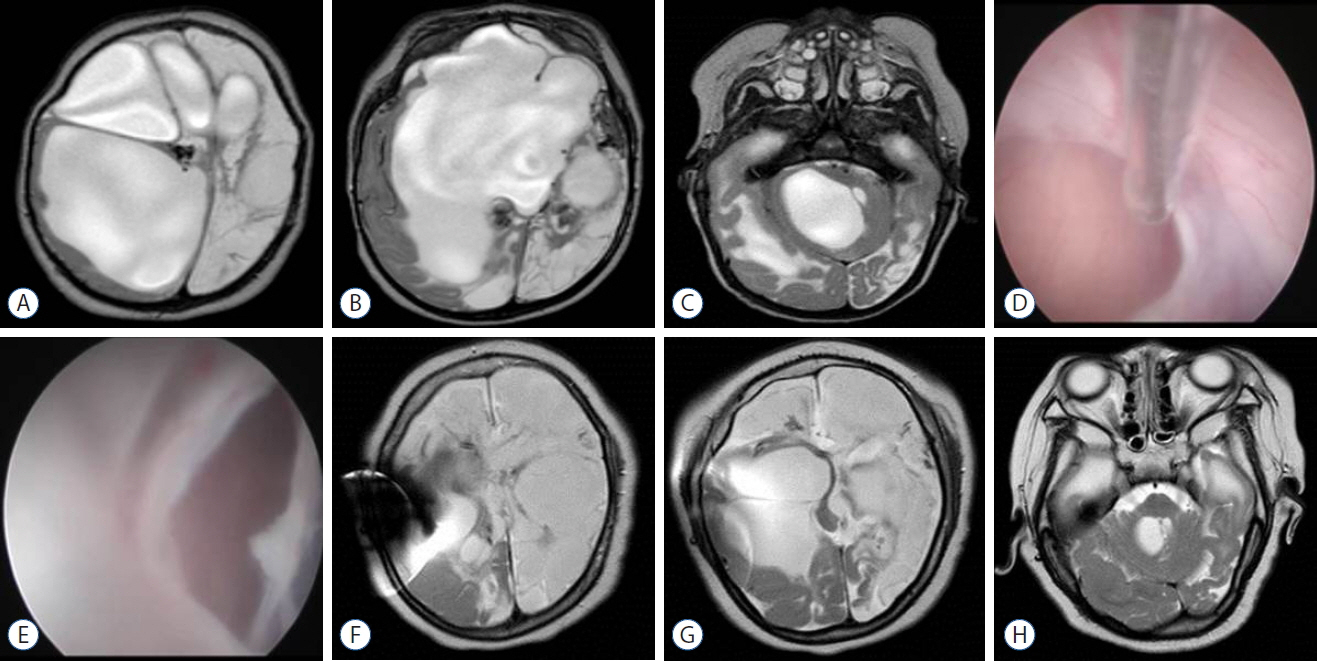J Korean Neurosurg Soc.
2017 May;60(3):301-305. 10.3340/jkns.2017.0101.013.
Multiloculated Hydrocephalus: Open Craniotomy or Endoscopy?
- Affiliations
-
- 1Department of Neurosurgery, National Health Insurance Service Ilsan Hospital, Goyang, Korea. khyang@nhimc.or.kr
- 2Department of Neurosurgery, School of Medicine, Kangwon National University, Chuncheon, Korea.
- KMID: 2382764
- DOI: http://doi.org/10.3340/jkns.2017.0101.013
Abstract
- Multiloculated hydrocephalus (MLH) is a condition in which patients have multiple, separate abnormal cerebrospinal fluid collections with no communication between them. Despite technical advancements in pediatric neurosurgery, neurological outcomes are poor in these patients and the approach to this pathology remains problematic especially given individual anatomic complexity and cerebrospinal fluid (CSF) hydrodynamics. A uniform surgical strategy has not yet been developed. Current treatment options for MLH are microsurgical fenestration of separate compartments by open craniotomy or endoscopy, shunt surgery in which multiple catheters are placed in the compartments, and combinations of these modalities. Craniotomy for fenestration allows better visualization of the compartments and membranes, and it can offer easy fenestration or excision of membranes and wide communication of cystic compartments. Hemostasis is more easily achieved. However, because of profound loss of CSF during surgery, open craniotomy is associated with an increased chance of subdural hygroma and/or hematoma collection and shunt malfunction. Endoscopy has advantages such as minimal invasiveness, avoidance of brain retraction, less blood loss, faster operation time, and shorter hospital stay. Disadvantages are also similar to those of open craniotomy. Intraoperative bleeding can usually be easily managed by irrigation or coagulation. However, handling of significant intraoperative bleeding is not as easy. Currently, endoscopic fenestration tends to be performed more often as initial treatment and open craniotomy may be useful in patients requiring repeated endoscopic procedures.
Keyword
MeSH Terms
Figure
Reference
-
References
1. Akbari SHA, Holekamp TF, Murphy TM, Mercer D, Leonard JR, Smyth MD, et al. Surgical management of complex multiloculated hydrocephalus in infants and children. Childs Nerv Syst. 31:243–249. 2015.
Article2. Albanese V, Tomasello F, Sampaolo S. Multiloculated hydrocephalus in infants. Neurosurgery. 8:641–646. 1981.
Article3. Andresen M, Juhler M. Multiloculated hydrocephalus: a review of current problems in classification and treatment. Childs Nerv Syst. 28:357–362. 2012.
Article4. Cipri S, Gambardella G. Neuroendoscopic approach to complex hydrocephalus. Personal experience and preliminary report. J Neurosurg Sci. 45:92–96. 2001.5. Eder HG, Leber KA, Gruber W. Complications after shunting isolated IV ventricles. Childs Nerv Syst. 13:13–16. 1997.
Article6. El-Ghandour NM. Endoscopic cyst fenestration in the treatment of multiloculated hydrocephalus in children. J Neurosurg Pediatr. 11:402–409. 2013.
Article7. Eller TW, Pasternak JF. Isolated ventricles following intraventricular hemorrhage. J Neurosurg. 62:357–362. 1985.
Article8. Hermann EJ, Esmaeilzadeh M, Ertl P, Polemikos M, Raab P, Krauss JK. Endoscopic intracranial surgery enhanced by electromagnetic-guided neuronavigation in children. Childs Nerv Syst. 31:1327–1333. 2015.
Article9. Jamjoom A, Mohammed A, Al-Boukai A, Jamjoom Z, Rahman N, Jamjoom H. Multiloculated hydrocephalus related to cerebrospinal fluid shunt infection. Acta Neurochir. 138:714–719. 1996.
Article10. Kalsbeck JE, DeSousa AL, Kleiman MB, Goodman JM, Franken EA. Compartmentalization of the cerebral ventricles as a sequela of neonatal meningitis. J Neurosurg. 52:547–552. 1980.
Article11. Kleinhaus S, Germann R, Sheran M, Shapiro K, Boley SJ. A role for endoscopy in the placement of ventriculoperitoneal shunts. Surg Neurol. 18:179–180. 1982.
Article12. Lewis AI, Crone KR. Advances in neuroendoscopy. Contemp Neurosurg. 16:1–6. 1994.
Article13. Lewis AI, Keiper GL Jr, Crone KR. Endoscopic treatment of loculated hydrocephalus. J Neurosurg. 82:780–785. 1995.
Article14. Marquardt G, Setzer M, Lang J, Seifert V. Delayed hydrocephalus after resection of supratentorial malignant gliomas. Acta Neurochir (Wien). 144:227–231. discussion 231. 2002.15. Nida TY, Haines SJ. Multiloculated hydrocephalus: craniotomy and fenestration of intraventricular septations. J Neurosurg. 78:70–76. 1993.
Article16. Nowosławska E, Polis L, Kaniewska D, Mikołajczyk W, Krawczyk J, Szymański W, et al. Effectiveness of neuroendoscopic procedures in the treatment of complex compartmentalized hydrocephalus in children. Childs Nerv Syst. 19:659–665. 2003.
Article17. Powers S. Fenestration of intraventricular cysts using a flexible, steerable endoscope. Bauer BL, Hellwig D, editors. Minimally Invasive Neurosurgery. ed 1. Vienna: Springer;1992. 54:p. 42–46.
Article18. Powers SK. Fenestration of intraventricular cysts using a flexible, steerable endoscope and the argon laser. Neurosurgery. 18:637–641. 1986.
Article19. Rhoten RP, Luciano MG, Barnett GH. Computer-assisted endoscopy for neurosurgical procedures: technical note. Neurosurgery. 40:632–638. discussion 638. 1997.
Article20. Rhoton AL Jr, Gomez MR. Conversion of multilocular hydrocephalus to unilocular: case report. J Neurosurg. 36:348–350. 1972.21. Rohde V, Behm T, Ludwig H, Wachter D. The role of neuronavigation in intracranial endoscopic procedures. Neurosurg Rev. 35:351–358. 2012.
Article22. Sandberg DI, McComb JG, Krieger MD. Craniotomy for fenestration of multiloculated hydrocephalus in pediatric patients. Neurosurgery. 57(1 Suppl):100–106. discussion 100–106. 2005.
Article23. Schultz P, Leeds NE. Intraventricular septations complicating neonatal meningitis. J Neurosurg. 38:620–626. 1973.
Article24. Schulz M, Bohner G, Knaus H, Haberl H, Thomale UW. Navigated endoscopic surgery for multiloculated hydrocephalus in children. J Neurosurg Pediatr. 5:434–442. 2010.
Article25. Teo C, Rahman S, Boop FA, Cherny B. Complications of endoscopic neurosurgery. Childs Nerv Syst. 12:248–253. discussion 253. 1996.
Article26. Zuccaro G, Ramos JG. Multiloculated hydrocephalus. Childs Nerv Syst. 27:1609–1619. 2011.
Article
- Full Text Links
- Actions
-
Cited
- CITED
-
- Close
- Share
- Similar articles
-
- A Case of Chronic Subdural Hematoma of Infact Developing Communicating Hydrocephalus
- Cystoperitoneal Shunting after Fenestration of an Enlarging Arachnoid Cyst
- A Case of the Suprasellar Arachnoid Cyst
- A Study on Cerebellar Hemorrhage
- Stereotactic Guided Craniotomy:Method for Localization and Removal of Small Intra-Axial Lesion


